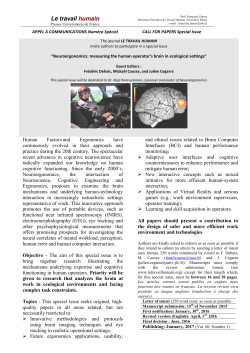
Ergonomics and ICT - home page corsi
Ergonomics and ICT Ing. Roberto Tedesco AA 2014-2015 Politecnico di Milano From: NCTE Advice Sheet – Ergonomics, Health and Safety http://www.pdsttechnologyineducation.ie What is Ergonomics? l l The study of how working conditions, machines and equipment can be arranged in order that people can work with them more efficiently Health problems: – Repeated strain injuries (RSI): recurrent large or small movements that affect joints, muscles, tendons, and nerve l – Diseases caused by unnatural postures and forces: people use their bodies in ways that induce physical stress l 2 – E.g.: swollen wrists and backache E.g.: the carpal tunnel syndrome results from pressure on the median nerve in the wrist Eye strain: struggling to read computer monitors may cause l E.g.: eye pain or redness, blurred or double vision, and headaches What to do l l l 3 Positioning of the person and equipment Arranging a safe environment Taking regular breaks www.ergonomics-info.com/posture-at-a-computer.html www.blendspace.com/lessons/jfIFn9MtEnW7IA/health-safety-in-the-ict-environment Positioning: desktop l l l 4 Sit up straight rather than slouch forward Use supports: foot rests, wrist rests and adjustable chairs Adjust equipment to the correct height, distance and angle www.blendspace.com/lessons/jfIFn9MtEnW7IA/health-safety-in-the-ict-environment Positioning: laptop (bad) 5 www.blendspace.com/lessons/jfIFn9MtEnW7IA/health-safety-in-the-ict-environment Positioning: laptop (good) 6 Positioning: Touchscreen-specific issues l Tablets and e-readers – – l Issues: – – – 7 Function vertically, horizontally, and anywhere in between Horizontal use is typically less stressful – Extended neck: users tend to bend the neck during typing, this can have serious health consequences Lack of back support: tablets encourage users to lean forward, especially during typing à users do not use backrests and the weight of their trunk is not properly supported Lack of elbow support: when seating on chairs with armrests, users tend to ignore arm support: they keep elbows in the air and shoulders raised à discomfort in shoulders and wrists on which the weight of an arm is resting Wrist angle during typing: flexed, extended, and deviated Positioning: Touchscreen-specific issues l l l Touchscreens positioned upright More problematic Issues: – – – 8 Force to use the large muscles in shoulder and arms Require to reach forward and lift arm against gravity, which tires muscles rapidly Dorsiflexion: a posture that puts more pressure on the median nerve and the other structures in the carpal tunnel in the wrist Arranging a safe environment 9 Arranging a safe environment 10 http://rjcooper.com/tablet-headpointer/ Ergonomics and disability l Bad postures: – Induced by assistive devices l – Induced by the disability l l E.g.: motor disabilities Low physical strength – Especially for arms, shoulder, neck, and back l 11 E.g.: head wands and mouth sticks Think of vertical touch screens… References l l l l l 12 ergonomics.org www.humanics-es.com/recc-disabled.htm www.ergonomics.org.uk/standards/ www.infoworld.com/article/2618327/laptop-computers/thehidden-danger-of-touchscreens.html K. M. Stawarz. An ergonomic evaluation of the potential impact of touch-screen tablets on office workers.
© Copyright 2025


















